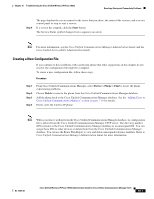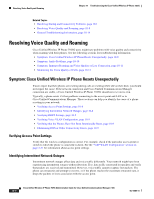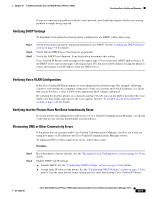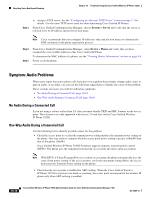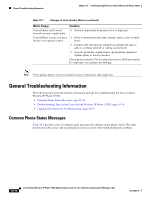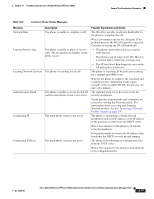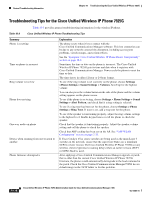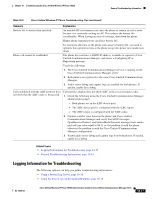Cisco 7925G Administration Guide - Page 208
Phone Does Not Roam Back to Preferred Band, Monitoring the Voice Quality of Calls
 |
UPC - 882658201943
View all Cisco 7925G manuals
Add to My Manuals
Save this manual to your list of manuals |
Page 208 highlights
Resolving Voice Quality and Roaming Chapter 10 Troubleshooting the Cisco Unified Wireless IP Phone 7925G • There might be an authentication type mismatch between the phone and the next access point. • The access point might be in a different subnet from the previous access point. The Cisco Unified Wireless IP Phone 7925G is capable of Layer 2 roaming only. Layer 3 roaming requires WLSM that uses GRE. For more information, see "WLANs and Roaming" section on page 2-7. • If using EAP-FAST, LEAP, or Auto (AKM) authentication, the access point might be using filters to block TCP ports. The ACS server uses port 1645 for authentication and 1646 for accounting and the RADIUS server uses port 1812 for authentication and 1813 for accounting. Phone Does Not Roam Back to Preferred Band When the Cisco Unified IP Phone 7960 is set to 5 GHz band as the preferred network and is authenticated to an AP on that band and roams to an area in which 5 GHz is not longer available but 2.4 GHz is available, the phone operates. But if you roam back to the 5 GHz band area, the phone will not return to the 5GHz band. Since the phone will only switch between bands when connectivity has been lost, you must reboot the phone to return to the preferred band of 5 GHz. Related Topics • Resolving Startup and Connectivity Problems, page 10-1 • Resolving Voice Quality and Roaming, page 10-8 • General Troubleshooting Information, page 10-14 • Monitoring the Voice Quality of Calls, page 10-12 Monitoring the Voice Quality of Calls To measure the voice quality of calls that are sent and received within the network, Cisco Unified IP Phones use these statistical metrics that are based on concealment events. The DSP plays concealment frames to mask frame loss in the voice packet stream. • Concealment Ratio metrics-Show the ratio of concealment frames over total speech frames. An interval conceal ratio is calculated every 3 seconds. • Concealed Second metrics-Show the number of seconds in which the DSP plays concealment frames due to lost frames. A severely "concealed second" is a second in which the DSP plays more than five percent concealment frames. • MOS-LQK metrics-Use a numeric score to estimate the relative voice listening quality. The Cisco Unified IP Phone calculates the mean opinion score (MOS) for listening quality (LQK) based audible concealment events due to frame loss in the preceding 8 seconds, and includes perceptual weighting factors such as codec type and frame size. MOS LQK scores are produced by a Cisco proprietary algorithm, Cisco Voice Transmission Quality (CVTQ) index. Depending on the MOS LQK version number, these scores might be compliant with the International Telecommunications Union (ITU) standard P.564. This standard defines evaluation methods and performance accuracy targets that predict listening quality scores based on observation of actual network impairment. 10-12 Cisco Unified Wireless IP Phone 7925G Administration Guide for Cisco Unified Communications Manager 7.0(1) OL-15984-01



